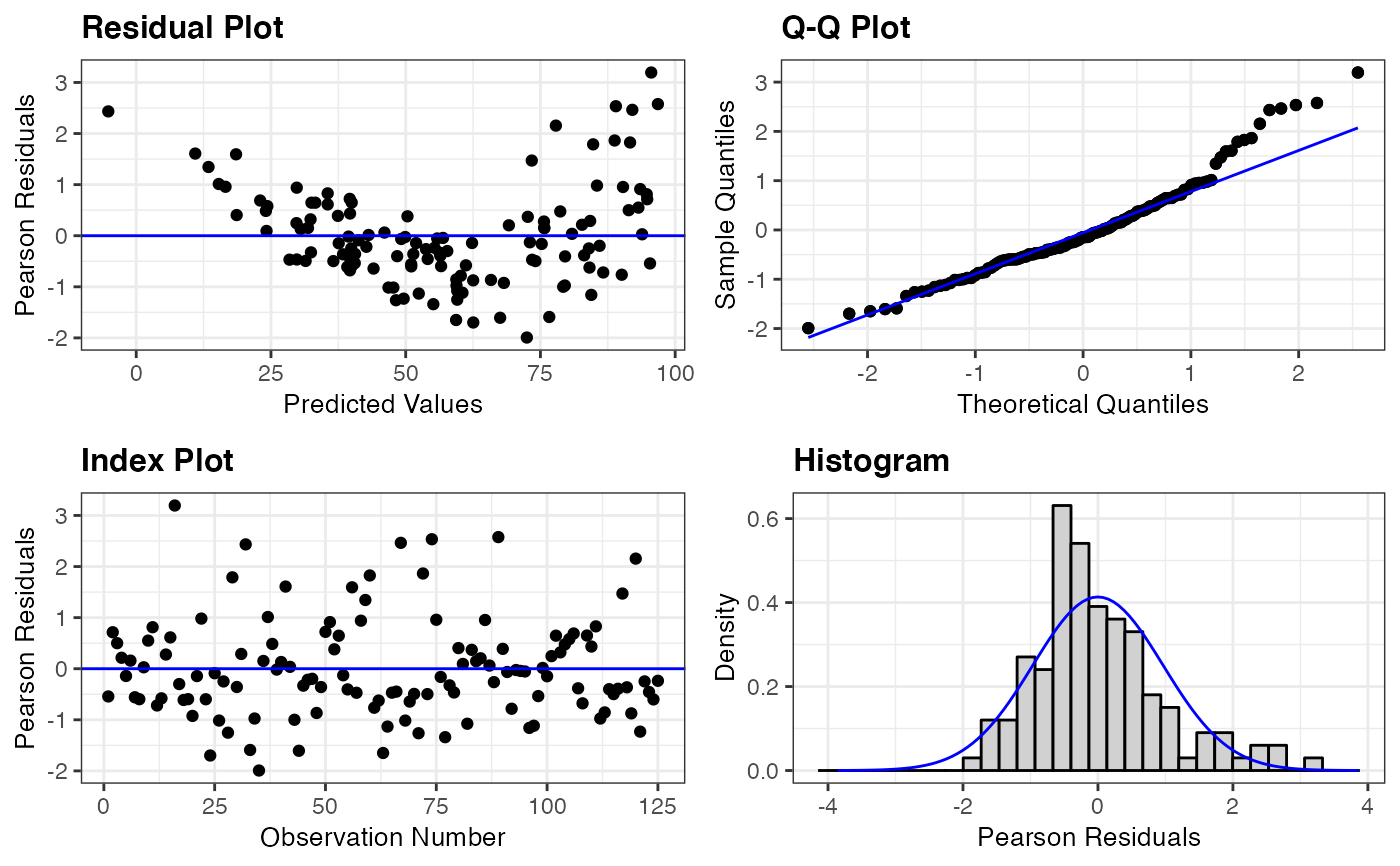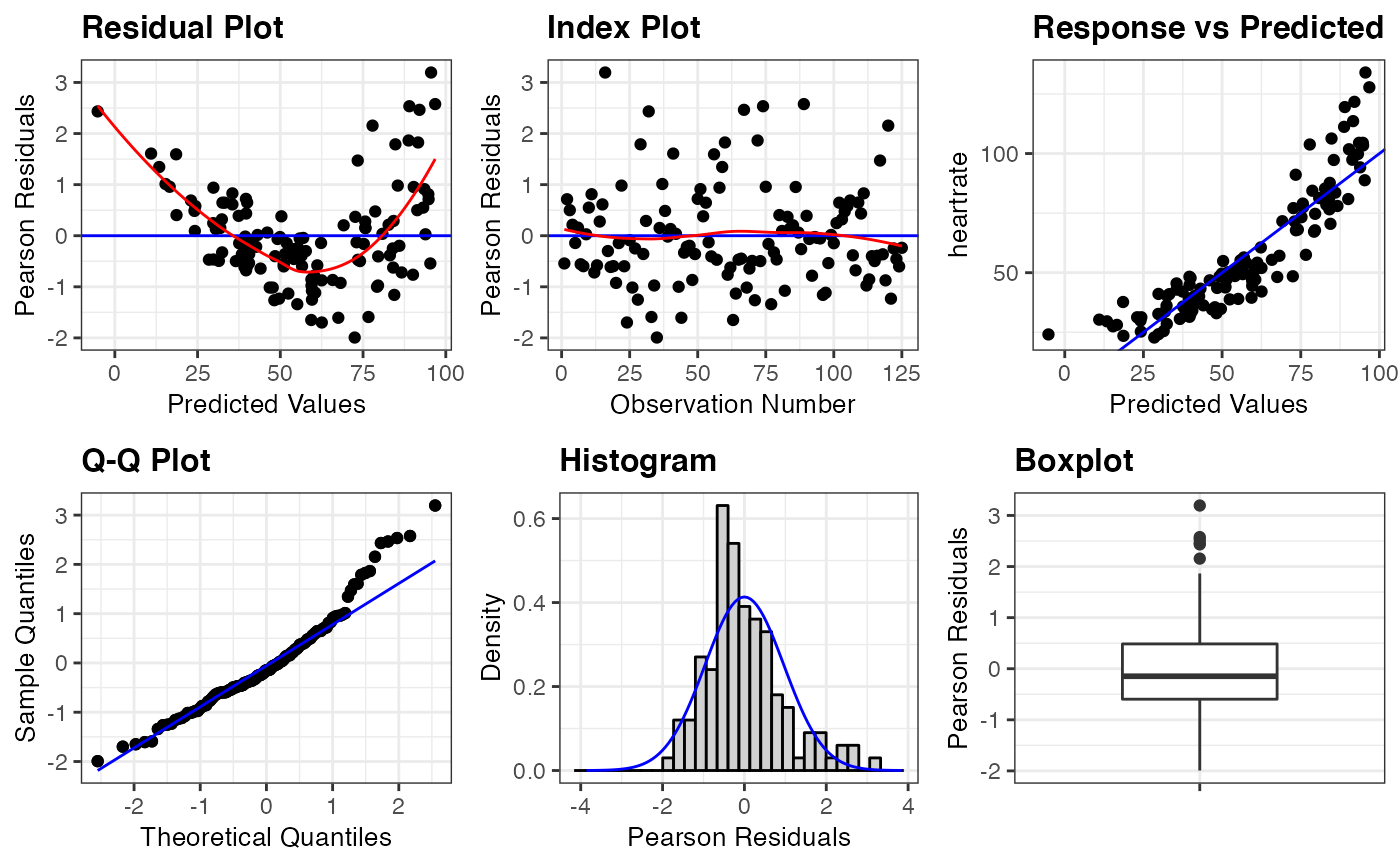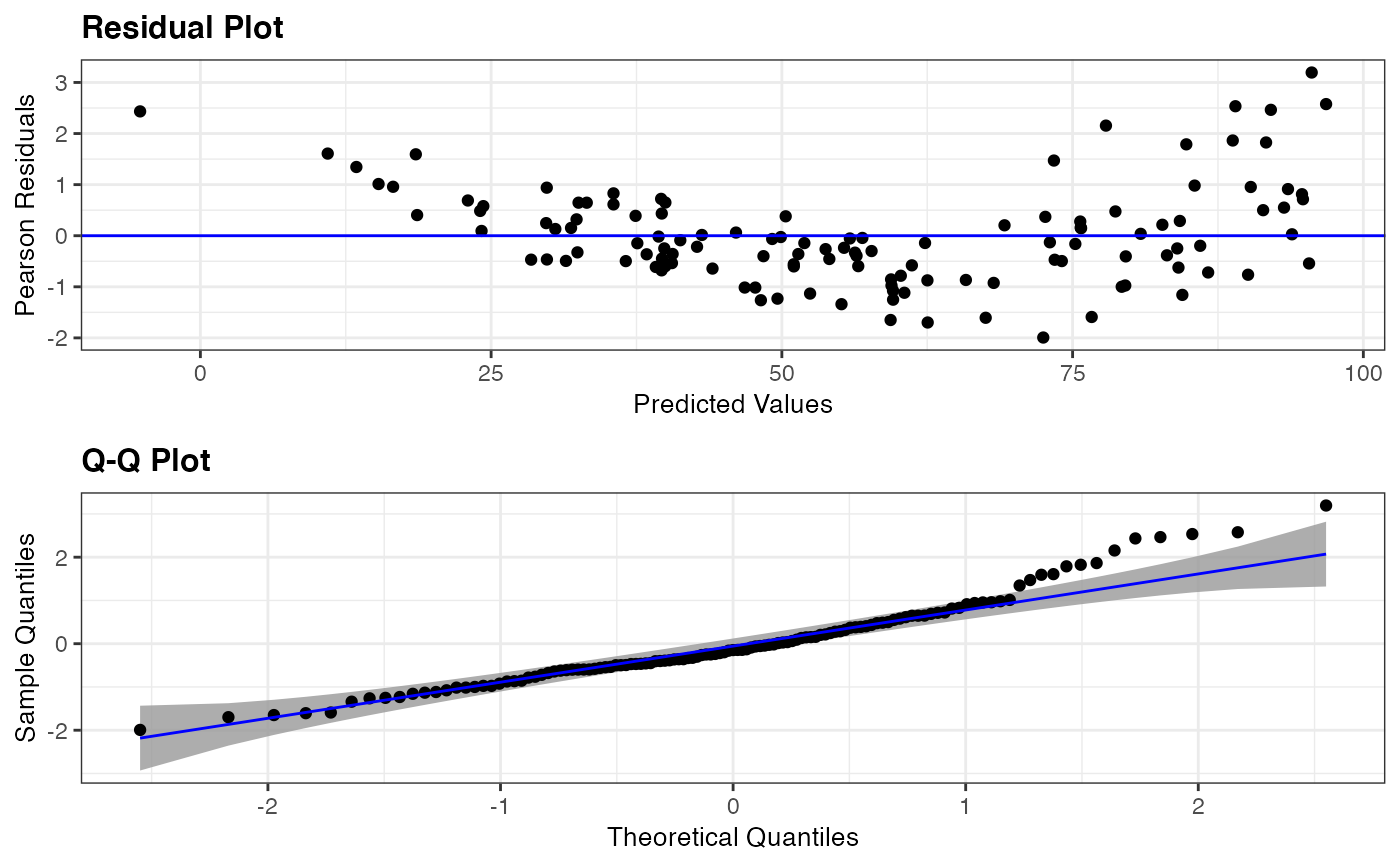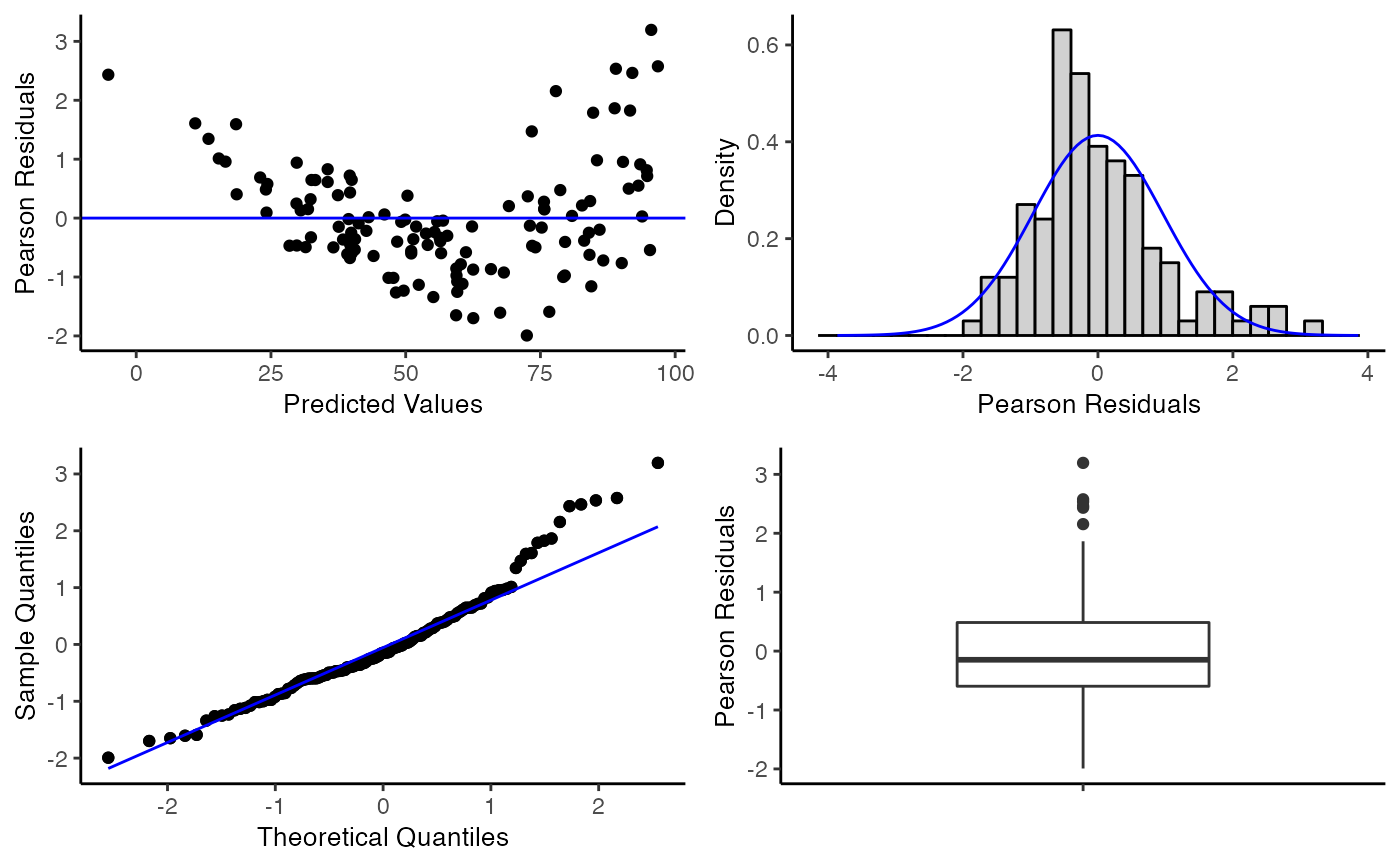Panel of Diagnostic Residual Plots.
resid_panel.RdCreates a panel of residual diagnostic plots given a model. Currently accepts models of type "lm", "glm", "lmerMod", "lmerModLmerTest", "lme", and "glmerMod".
resid_panel(
model,
plots = "default",
type = NA,
bins = 30,
smoother = FALSE,
qqline = TRUE,
qqbands = FALSE,
scale = 1,
theme = "bw",
axis.text.size = 10,
title.text.size = 12,
title.opt = TRUE,
nrow = NULL
)Arguments
- model
Model fit using either
lm,glm,lmer,lmerTest,lme, orglmer.- plots
Plots chosen to include in the panel of plots. The default panel includes a residual plot, a normal quantile plot, an index plot, and a histogram of the residuals. (See details for the options available.)
- type
Type of residuals to use in the plot. If not specified, the default residual type for each model type is used. (See details for the options available.)
- bins
Number of bins to use when creating a histogram of the residuals. Default is set to 30.
- smoother
Indicates whether or not to include a smoother on the index, residual-leverage, location-scale, and residual plots. Specify TRUE or FALSE. Default is set to FALSE.
- qqline
Indicates whether to include a 1-1 line on the qq-plot. Specify TRUE or FALSE. Default is set to TRUE.
- qqbands
Indicates whether to include confidence bands on the qq-plot. Specify TRUE or FALSE. Default is set to FALSE.
- scale
Scales the size of the graphs in the panel. Takes values in (0,1].
- theme
ggplot2 theme to be used. Current options are
"bw","classic", and"grey"(or"gray"). Default is"bw".- axis.text.size
Specifies the size of the text for the axis labels of all plots in the panel.
- title.text.size
Specifies the size of the text for the titles of all plots in the panel.
- title.opt
Indicates whether or not to include a title on the plots in the panel. Specify TRUE or FALSE. Default is set to TRUE.
- nrow
Sets the number of rows in the panel.
Value
A panel of residual diagnostic plots containing plots specified.
Details
The first two sections below contain information on the available input
options for the plots and type arguments in resid_panel.
The third section contains details relating to the creation of the plots.
Options for Plots
The following options can be chosen for the plots argument.
"all": This creates a panel of all plot types included in the package that are available for the model type input into
resid_panel. (See note below.)"default": This creates a panel with a residual plot, a normal quantile plot of the residuals, an index plot of the residuals, and a histogram of the residuals.
"R": This creates a panel with a residual plot, a normal quantile plot of the residuals, a location-scale plot, and a residuals versus leverage plot. This was modeled after the plots shown in R if the
plot()base function is applied to anlmmodel. This option can only be used with anlmorglmmodel."SAS": This creates a panel with a residual plot, a normal quantile plot of the residuals, a histogram of the residuals, and a boxplot of the residuals. This was modeled after the residualpanel option in proc mixed from SAS version 9.4.
A vector of individual plots can also be specified. For example, one can specify
plots = c("boxplot", "hist")orplots = "qq". The individual plot options are as follows."boxplot": A boxplot of residuals"cookd": A plot of Cook's D values versus observation numbers"hist": A histogram of residuals"index": A plot of residuals versus observation numbers"ls": A location scale plot of the residuals"qq": A normal quantile plot of residuals"lev": A plot of standardized residuals versus leverage values"resid": A plot of residuals versus predicted values"yvp":: A plot of observed response values versus predicted values
Note: "cookd", "ls", and "lev" are only available for "lm" and
"glm" models.
Options for Type
Several residual types are available to be requested based on the model type
that is input into resid_panel. These currently are as follows.
lmresidual options"pearson":The Pearson residuals"response": The raw residuals (Default for "lm")"standardized": The standardized raw residuals
glmresidual options"pearson": The Pearson residuals"deviance": The deviance residuals (Default for "glm")"response": The raw residuals"stand.deviance": The standardized deviance residuals"stand.pearson": The standardized Pearson residuals
lmer,lmerTest, andlmeresidual options"pearson": The Pearson residuals (Default for "lmer", "lmerTest", and "lme")"response": The raw residuals
glmerresidual options"pearson": The Pearson residuals"deviance": The deviance residuals (Default for "glmer")"response": The raw residuals
Note: The plots of "ls" and "lev" only accept standardized residuals.
Details on the Creation of Plots
- Boxplot (
boxplot) Boxplot of the residuals.
- Cook's D (
cookd) The horizontal line represents a cut-off to identify highly influential points. The horizontal line is placed at 4/n where n is the number of data points used in the
model.- Histogram (
hist) Plots a histogram of the residuals. The density curve overlaid has mean equal to zero and standard deviation equal to the standard deviation of the residuals.
- Index Plot (
index) Plots the residuals on the y-axis and the observation number associated with the residual on the x-axis.
- Residual-Leverage Plot (
lev) Plots the standardized residuals on the y-axis and the leverage values on the x-axis with a loess curve is overlaid. Cook's D contour lines (which are a function of leverage and standardized residuals) are plotted as the red dashed lines for Cook's D values of 0.5 and 1.
- Location-Scale Plot (
ls) Plots the square root of the absolute value of the standardized residuals on the y-axis and the predicted values on the x-axis. The predicted values are plotted on the original scale for
glmandglmermodels. A loess curve is overlaid.- QQ Plot (
qq) Makes use of the
Rpackageqqplotrfor creating a normal quantile plot of the residuals.- Residual Plot (
resid) Plots the residuals on the y-axis and the predicted values on the x-axis. The predicted values are plotted on the original scale for
glmandglmermodels.- Response vs. Predicted (
yvp) Plots the response variable from the model on the y-axis and the predicted values on the x-axis. Both response variable and predicted values are plotted on the original scale for
glmandglmermodels.
Examples
# Fit a model to the penguin data
penguin_model <- lme4::lmer(heartrate ~ depth + duration + (1|bird), data = penguins)
# Create the default panel
resid_panel(penguin_model)
 # Select all plots to include in the panel and set the smoother option to TRUE
resid_panel(penguin_model, plots = "all", smoother = TRUE)
#> `geom_smooth()` using formula 'y ~ x'
#> `geom_smooth()` using formula 'y ~ x'
# Select all plots to include in the panel and set the smoother option to TRUE
resid_panel(penguin_model, plots = "all", smoother = TRUE)
#> `geom_smooth()` using formula 'y ~ x'
#> `geom_smooth()` using formula 'y ~ x'
 # Select only the residual plot and qq-plot to be included in the panel,
# request confidence bands on the qq plot, and set the number of rows to 2
resid_panel(penguin_model, plots = c("resid", "qq"), qqbands = TRUE, nrow = 2)
# Select only the residual plot and qq-plot to be included in the panel,
# request confidence bands on the qq plot, and set the number of rows to 2
resid_panel(penguin_model, plots = c("resid", "qq"), qqbands = TRUE, nrow = 2)
 # Choose the SAS panel of plots, change the theme to classic, and remove the
# titles of the plots
resid_panel(penguin_model, plots = "SAS", theme = "classic", title.opt = FALSE)
# Choose the SAS panel of plots, change the theme to classic, and remove the
# titles of the plots
resid_panel(penguin_model, plots = "SAS", theme = "classic", title.opt = FALSE)
